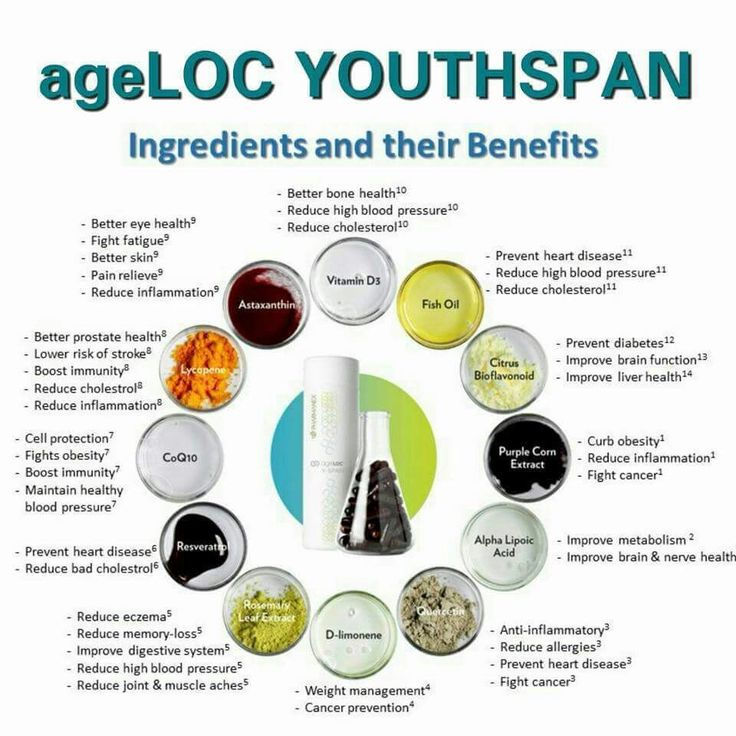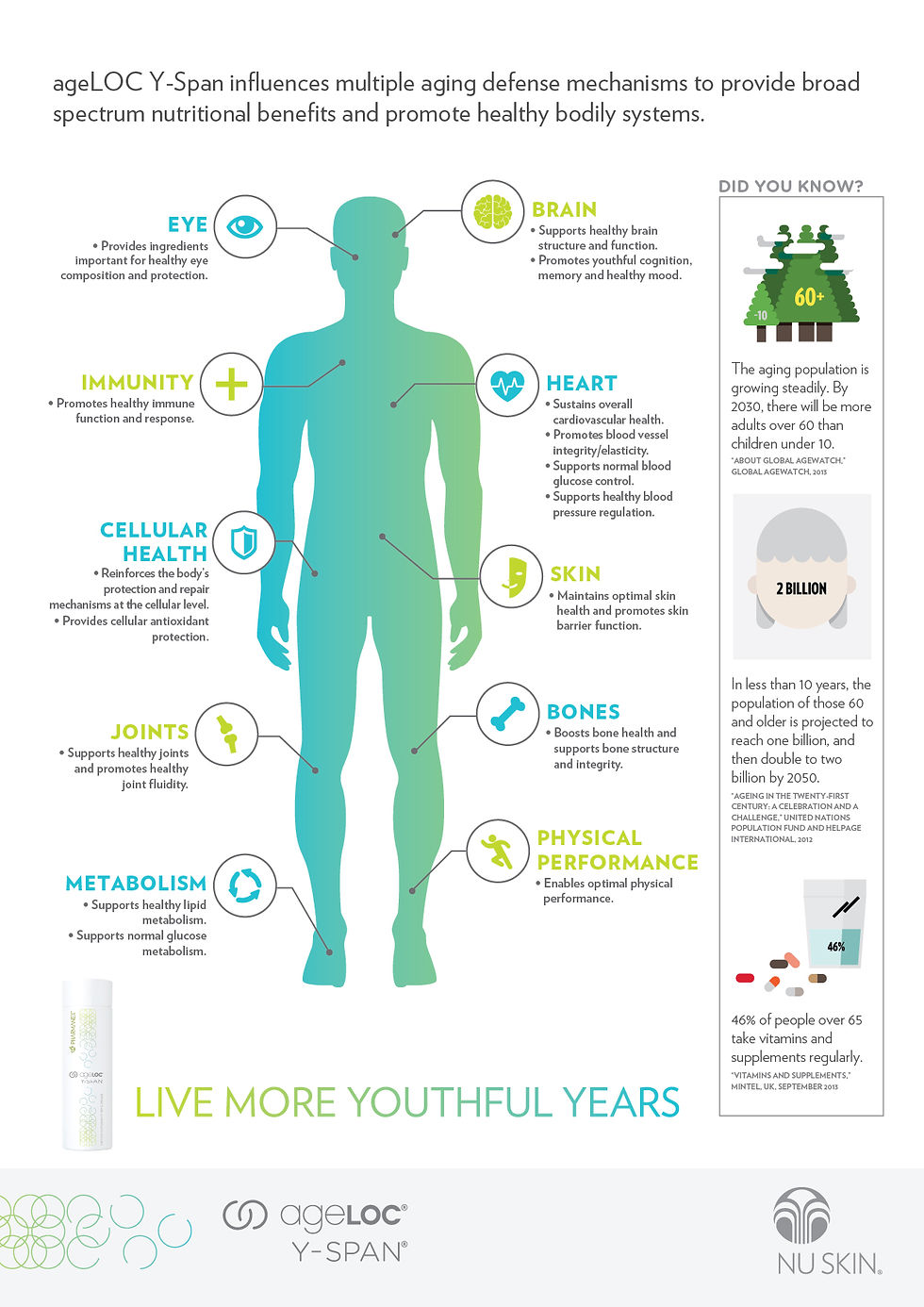Supporting Aging Defense Mechanisms with ageLOC Youth
- Lu Cheng
- Apr 10, 2018
- 6 min read

Aging is characterized by a gradual accumulation of cellular and molecular damage caused in part by exposure to aging aggressors. Aging aggressors include a diverse range of exposures, both inside and outside our bodies, that accelerate aging and include things such as environmental pollutants, sun exposure, psychosocial stress, inflammation, smoking, metabolic byproducts, and cellular stress. This leads to cellular, tissue, organ, and body systems dysfunction. To defend against these aging aggressors and help maintain youthfulness, our bodies have a network of naturally occurring mechanisms we call aging defense mechanisms. Aging defense mechanisms operate most optimally when we are young, maximally protecting us against aging aggressors. However, with time, our aging defense mechanisms tend to decline in function and efficiency, leaving us more vulnerable to the damaging effects of aging aggressors.

Aging defense mechanisms are regulated via gene expression. Age-related changes in gene expression help to explain much of the loss of function and efficiency of aging defense mechanisms that occur with age. With this in mind, Nu Skin scientists set out to understand how these changes in gene expression impact the modulation of aging defense mechanisms. By targeting the gene expression of our aging defense mechanisms, Nu Skin scientists have formulated a unique blend of active ingredients that support aging defense mechanisms and provide systemic, whole-body, anti-aging benefits to support youthfulness.
IMPORTANCE OF SUPPORTING AGING DEFENSE MECHANISMS
The brain is made up of several different types of cells, which are negatively affected by multiple aging aggressors. To combat aging aggressors, it is important to support not just one aging defense mechanism, but to support several, simultaneously. If you only supplement antioxidants, the brain tissue is vulnerable to other damaging aging aggressors that are not as affected by antioxidants. A more comprehensive and effective approach is to target multiple aging defense mechanisms in the brain such as DNA repair, regulation of inflammatory balance, regulation of metabolism, cellular detoxification, and cellular renewal, as well as those mechanisms responsible for antioxidant protection.
EXAMPLES OF NATURAL INGREDIENTS TO SUPPORT AGING DEFENSE MECHANISMS
Targeting multiple mechanisms provides a more effective strategy against aging aggressors. While no single ingredient has been identified that supports all defense mechanisms, there are several natural ingredients that positively influence different aging defense mechanisms in the brain. For example, fatty acids found in fish oil are known to have a positive effect on neural membrane fluidity and permeability, receptor structure and quantity, and cell-to-cell communication involved in the regulation of inflammatory balance [1]. Studies of fish oil fatty acid supplementation have demonstrated beneficial effects in the brain [2, 3]. Some of these effects include the support of brain tissue renewal [4], improvements in cognitive function [5], support of inflammatory balance [6, 7], and enhanced working memory [8–12]. Similarly, other nutrients such as flavonoids [13, 14], alpha lipoic acid [15], carotenoids [16], and vitamin D [17, 18] can support healthy brain function and cognition as well as support several aging defense mechanisms.
Another example of age-related changes is found in the heart and cardiovascular system. Aging aggressors like chronic low-grade inflammation, lipid dysregulation, hypertension, oxidative damage, platelet activation, cellular stress, and decreased cellular detoxification can all have a negative influence on this critical body system [19]. Several aging defense mechanisms are found throughout the heart and cardiovascular system to defend against aging aggressors. There is evidence that a number of nutrients and plant compounds support several of these defense mechanisms in the cardiovascular system. Some of these nutrients include resveratrol [20, 21], quercetin [22, 23], vitamin K2 [24, 25], CoQ10 [26–28], and fish oil [29–32].

AGING DEFENSE MECHANISMS AND AGELOC YOUTH
Aging defense mechanisms such as those that control DNA repair, cellular detoxification, inflammation, tissue renewal, and metabolic control decline in function and efficiency with age. This leaves us more vulnerable to aging aggressors. To combat these aging aggressors and maintain youthfulness, Nu Skin scientists have formulated ageLOC Youth. Based on proprietary gene expression science related to the regulation of aging defense mechanisms, ageLOC Youth delivers a potent blend of anti-aging nutrients and phytochemicals (various biologically active compounds found in plants) that would be difficult to obtain even through a healthy diet. Through Nu Skin’s proprietary scientific approach, we have identified some of the best natural ingredients to positively modulate gene expression related to aging defense mechanisms, providing systemic, whole-body benefits to support youthfulness. We’re excited to bring you ageLOC Youth, a novel anti-aging dietary supplement that targets the sources of aging to help you enjoy life, be more active and energetic, and live younger longer.*

Its not only about adding years to your lives, but more about adding lives to your years! Embrace youth!


Written by:
Steven M. Wood, Ph.D., RD
Global Research and DevelopmentPharmanex
*These statements have not been evaluated by the Food and Drug Administration. This product is not intended to diagnose, treat, cure, or prevent any disease.
Sources
1. Sumida, C., R. Graber, and E. Nunez, Role of fatty acids in signal transduction: modulators and messengers. Prostaglandins Leukot Essent Fatty Acids, 1993. 48(1): p. 117-22.
2. Witte, A.V., et al., Long-chain omega-3 fatty acids improve brain function and structure in older adults. Cereb Cortex, 2014. 24(11): p. 3059-68.
3. Afshordel, S., et al., Omega-3 polyunsaturated fatty acids improve mitochondrial dysfunction in brain aging--impact of Bcl-2 and NPD-1 like metabolites. Prostaglandins Leukot Essent Fatty Acids, 2015. 92: p. 23-31.
4. Janssen, C.I. and A.J. Kiliaan, Long-chain polyunsaturated fatty acids (LCPUFA) from genesis to senescence: the influence of LCPUFA on neural development, aging, and neurodegeneration. Prog Lipid Res, 2014. 53: p. 1-17.
5. Narendran, R., et al., Improved working memory but no effect on striatal vesicular monoamine transporter type 2 after omega-3 polyunsaturated fatty acid supplementation. PLoS One, 2012. 7(10): p. e46832.
6. Bouwens, M., et al., Fish-oil supplementation induces antiinflammatory gene expression profiles in human blood mononuclear cells. Am J Clin Nutr, 2009. 90(2): p. 415-24.
7. Micallef, M.A. and M.L. Garg, Anti-inflammatory and cardioprotective effects of n-3 polyunsaturated fatty acids and plant sterols in hyperlipidemic individuals. Atherosclerosis, 2009. 204(2): p. 476-82.
8. Stonehouse, W., et al., DHA supplementation improved both memory and reaction time in healthy young adults: a randomized controlled trial. Am J Clin Nutr, 2013. 97(5): p. 1134-43.
9. Haberka, M., et al., Effects of n-3 polyunsaturated fatty acids on depressive symptoms, anxiety and emotional state in patients with acute myocardial infarction. Pharmacol Rep, 2013. 65(1): p. 59-68.
10. Matsuoka, Y., et al., Potential role of brain-derived neurotrophic factor in omega-3 Fatty Acid supplementation to prevent posttraumatic distress after accidental injury: an open-label pilot study. Psychother Psychosom, 2011. 80(5): p. 310-2.
11. Sontrop, J. and M.K. Campbell, Omega-3 polyunsaturated fatty acids and depression: a review of the evidence and a methodological critique. Prev Med, 2006. 42(1): p. 4-13.
12. Rizzo, A.M., et al., Comparison between the AA/EPA ratio in depressed and non depressed elderly females: omega-3 fatty acid supplementation correlates with improved symptoms but does not change immunological parameters. Nutr J, 2012. 11: p. 82.
13. Spencer, J.P., Beyond antioxidants: the cellular and molecular interactions of flavonoids and how these underpin their actions on the brain. Proc Nutr Soc, 2010. 69(2): p. 244-60.
14. Rendeiro, C., J.S. Rhodes, and J.P. Spencer, The mechanisms of action of flavonoids in the brain: Direct versus indirect effects.Neurochem Int, 2015. 89: p. 126-39.
15. Alpha-lipoic acid. Monograph. Altern Med Rev, 2006. 11(3): p. 232-7.
16. Devore, E.E., et al., The association of antioxidants and cognition in the Nurses' Health Study. Am J Epidemiol, 2013. 177(1): p. 33-41.
17. Murphy, P.K. and C.L. Wagner, Vitamin D and mood disorders among women: an integrative review. J Midwifery Womens Health, 2008. 53(5): p. 440-6.
18. Patrick, R.P. and B.N. Ames, Vitamin D and the omega-3 fatty acids control serotonin synthesis and action, part 2: relevance for ADHD, bipolar, schizophrenia, and impulsive behavior. FASEB J, 2015.
19. Bernhard, D. and G. Laufer, The aging cardiomyocyte: a mini-review. Gerontology, 2008. 54(1): p. 24-31.
20. Magyar, K., et al., Cardioprotection by resveratrol: A human clinical trial in patients with stable coronary artery disease. Clin Hemorheol Microcirc, 2012. 50(3): p. 179-87.
21. Zamora-Ros, R., et al., High urinary levels of resveratrol metabolites are associated with a reduction in the prevalence of cardiovascular risk factors in high-risk patients. Pharmacol Res, 2012. 65(6): p. 615-20.
22. Hubbard, G.P., et al., Ingestion of onion soup high in quercetin inhibits platelet aggregation and essential components of the collagen-stimulated platelet activation pathway in man: a pilot study. Br J Nutr, 2006. 96(3): p. 482-8.
23. Edwards, R.L., et al., Quercetin reduces blood pressure in hypertensive subjects. J Nutr, 2007. 137(11): p. 2405-11.
24. Beulens, J.W., et al., High dietary menaquinone intake is associated with reduced coronary calcification. Atherosclerosis, 2009. 203(2): p. 489-93.
25. Gast, G.C., et al., A high menaquinone intake reduces the incidence of coronary heart disease. Nutr Metab Cardiovasc Dis, 2009. 19(7): p. 504-10.
26. Coenzyme Q10. Monograph. Altern Med Rev, 2007. 12(2): p. 159-68.
27. Tiano, L., et al., Effect of coenzyme Q10 administration on endothelial function and extracellular superoxide dismutase in patients with ischaemic heart disease: a double-blind, randomized controlled study. Eur Heart J, 2007. 28(18): p. 2249-55.
28. Belardinelli, R., et al., Coenzyme Q10 improves contractility of dysfunctional myocardium in chronic heart failure. Biofactors, 2005. 25(1-4): p. 137-45.
29. Thies, F., et al., Influence of dietary supplementation with long-chain n-3 or n-6 polyunsaturated fatty acids on blood inflammatory cell populations and functions and on plasma soluble adhesion molecules in healthy adults. Lipids, 2001. 36(11): p. 1183-93.
30. Guillot, N., et al., Increasing intakes of the long-chain omega-3 docosahexaenoic acid: effects on platelet functions and redox status in healthy men. FASEB J, 2009. 23(9): p. 2909-16.
31. Carter, J.R., et al., Fish oil and neurovascular reactivity to mental stress in humans. Am J Physiol Regul Integr Comp Physiol, 2013. 304(7): p. R523-30.
32. Noreen, E.E. and J. Brandauer, The effects of supplemental fish oil on blood pressure and morning cortisol in normotensive adults: a pilot study. J Complement Integr Med, 2012. 9.







Comments